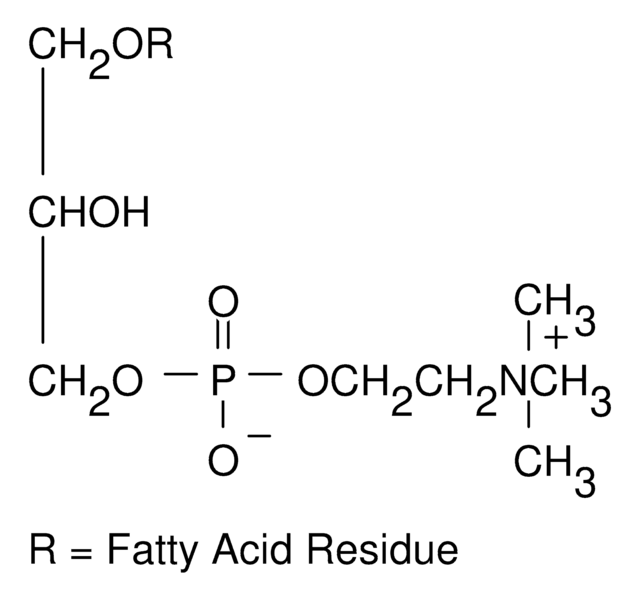857130C
Avanti
18:1 Lyso PA
1-oleoyl-2-hydroxy-sn-glycero-3-phosphate (sodium salt), chloroform
Synonyme(s) :
oleoyl lysophosphatidic acid; 1-(9Z-octadecenoyl)-sn-glycero-3-phosphate (sodium salt); PA(18:1(9Z)/0:0); 18:1 LPA; o-LPA; 110681
About This Item
Produits recommandés
Essai
>99% (LPA; may contain up to 10% of the 2-LPA isomer, TLC)
Forme
liquid
Conditionnement
pkg of 1 × 2.5 mL (857130C-25mg)
pkg of 2 × 4 mL (857130C-200mg)
Fabricant/nom de marque
Avanti Research™ - A Croda Brand 857130C
Concentration
10 mg/mL (857130C-25mg)
25 mg/mL (857130C-200mg)
Type de lipide
cardiolipins
phospholipids
Conditions d'expédition
dry ice
Température de stockage
−20°C
Chaîne SMILES
[Na+].[P](=O)([O-])(OC[C@H](O)COC(=O)CCCCCCC\C=C/CCCCCCCC)O
InChI
1S/C21H41O7P.Na/c1-2-3-4-5-6-7-8-9-10-11-12-13-14-15-16-17-21(23)27-18-20(22)19-28-29(24,25)26;/h9-10,20,22H,2-8,11-19H2,1H3,(H2,24,25,26);/q;+1/p-1/b10-9-;/t20-;/m1./s1
Clé InChI
XGRLSUFHELJJAB-JGSYTFBMSA-M
Catégories apparentées
Description générale
Application
- for liposome preparations
- to study its apoptotic effect in HeLa cells
- to determine the extraction recovery of LPA at neutral pH and acidic pH by chromatography
- to use as a LPA agonist supplement in oocytes maturation medium to study its effects during in vitro maturation of bovine cumulus–oocyte complexes
Actions biochimiques/physiologiques
Conditionnement
Informations légales
Mention d'avertissement
Danger
Mentions de danger
Classification des risques
Acute Tox. 3 Inhalation - Acute Tox. 4 Oral - Aquatic Chronic 3 - Carc. 2 - Eye Irrit. 2 - Repr. 2 - Skin Irrit. 2 - STOT RE 1 - STOT SE 3
Organes cibles
Central nervous system, Liver,Kidney
Code de la classe de stockage
6.1D - Non-combustible acute toxic Cat.3 / toxic hazardous materials or hazardous materials causing chronic effects
Classe de danger pour l'eau (WGK)
WGK 3
Point d'éclair (°F)
does not flash
Point d'éclair (°C)
does not flash
Listes réglementaires
Les listes réglementaires sont principalement fournies pour les produits chimiques. Seules des informations limitées peuvent être fournies ici pour les produits non chimiques. L'absence d'indication signifie qu'aucun des composants n'est répertorié. Il incombe à l'utilisateur de s'assurer de l'utilisation sûre et légale du produit.
EU REACH Annex XVII (Restriction List)
Faites votre choix parmi les versions les plus récentes :
Certificats d'analyse (COA)
It looks like we've run into a problem, but you can still download Certificates of Analysis from our Documents section.
Si vous avez besoin d'assistance, veuillez contacter Service Clients
Déjà en possession de ce produit ?
Retrouvez la documentation relative aux produits que vous avez récemment achetés dans la Bibliothèque de documents.
Les clients ont également consulté
Notre équipe de scientifiques dispose d'une expérience dans tous les secteurs de la recherche, notamment en sciences de la vie, science des matériaux, synthèse chimique, chromatographie, analyse et dans de nombreux autres domaines..
Contacter notre Service technique















